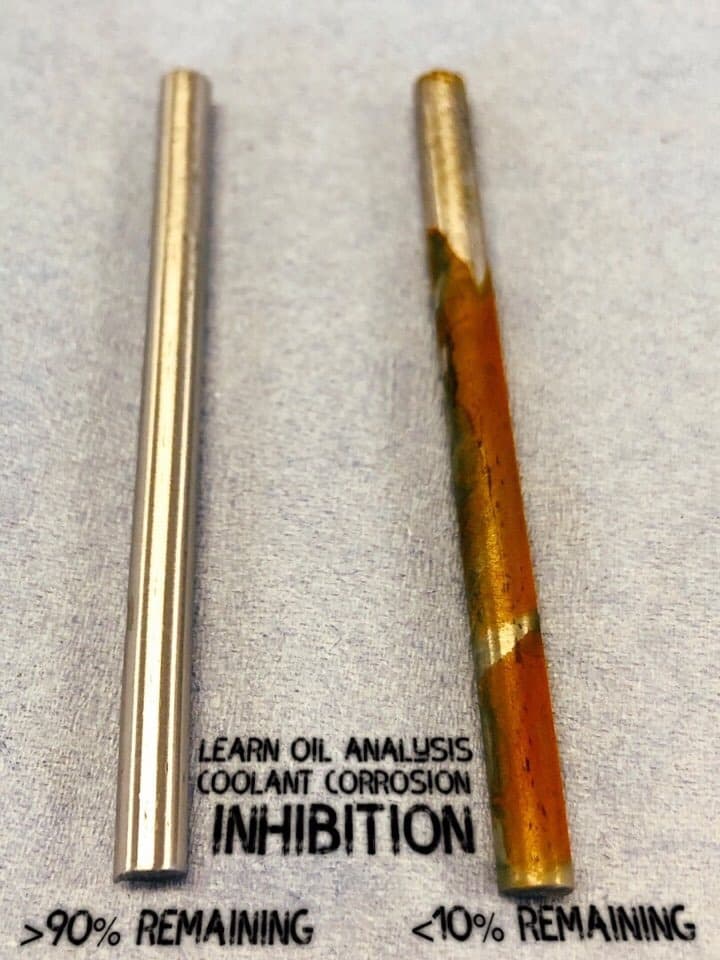This article will answer the following questions.
- Why does my cooling system not rust?
- What does antifreeze do?
- What is in antifreeze?
- What are corrosion inhibitors?
-
What are Supplementary Coolant Additives (SCAs)
- What is vapour phase corrosion inhibition?
Your coolant in your engine is usually between 50% and 70% water and even more on cooling waters where it can be up to 90%. So with all that water why does your cooling system not rust? It is fair to say that a lot of material is not iron and is Aluminium or Copper because of their excellent heat exchange properties. However it is very difficult to have anything structural made of metal without using iron because of its great properties including strength. Hence your cooling system still contains iron and more importantly the contacting points with the cylinder bores, i.e. liners are made of iron. It is corrosion, not just by rusting but by removal of material called pinhole corrosion that causes problems like porous liners and coolant leaks.
“80% of major engine failures are coolant related.”
Although around 80% of major engine failures are coolant related most of the time your coolant system is fine and that is because coolant corrosion inhibitor additives are added to the coolant to protect the system.
Types of corrosion inhibitor
The choice is very often regional in that in Europe Sodium is the predominant metal cation, whereas in North America Potassium is. This is dependent on the Additive manufacturers, but with globalisation at least from my experience of the European market it is not uncommon to see both in some coolants.
Traditional coolants (in-organic)
In addition to the sodium anion the molecule needs to have an anion as well. These can be in Europe Silicates, in USA both Silicates and Phosphates and in Asia just Phosphates. Although depending on where the coolant manufacturer buys their additives the geographical rules don’t necessarily always apply.
Metal silicates very easily dissolve in cooling fluids, but when in the presence of metal oxides and hydroxides especially iron ones (I.e. rust) the silicates form silicon dioxides,precipitate out of solution and form a silica gel protective coating. This process is called anodic inhibition and the additives are also called metal passivators.
If adding additional coolant additives manually as Supplementary Coolant Additives (SCA) to the coolant, there is a fine line, as too much silicates can lead to mass deposition, block coolant system pathways and lead to reduced heat exchange.
Other anoidic corrosion inhibitors include phosphates, molybdates, borates and nitrites.
In terms of cathodic corrosion inhibitors these are usually not dissolved additives (although in rare cases they can be), but sacraficial Zinc pencils etc added to cooling systems to selectively oxidise. The oxidised zinc in solution precipitates and blocks further corrosion of other metals in the system.
OAT (Organic Acid Techbologies)
OAT coolants use organic additives such as carboxylates. The advantage being:
- They don’t contain some of the inorganic additives such as silicates that can lead to deposition in the system.
- They tend to last longer.
- They don’t contain inorganic compounds that are frowned upon such as borates and phosphates.
They have had some controversy with specific additives that were also plasticisers affecting seals and hoses within cooling systems back in the early 2000s, although this has been largely resolved now after some well publicised court cases in North America with major OEMS.
The most common corrosion inhibitor is sodium benzoate.
Carboxylates form a hydrophobic film (this means oily and water hating) layer on metal surfaces acting as both anodic and cathodic passivators to give a total coating of the systems and prevent access of the corrosive water and oxygen mix to the metal surface.
Hybrid Organic Acid Technologies (HOATS)
These are essentially mixes of traditional and OAT coolants to achieve the desired properties.
The importance of pH in coolants
Coolants are slightly alkali and pH is important not only as too acid or alkali environents cause corrosion, but because the coolant corrosion additives need a very precise pH range to work in.
Volatile Corrosion Inhibitors (Vapour Phase Corrosion Inhibitors)
So far we have spoken about liquid corrosion inhibitors, which is great for the contacting surfaces, but what about just above the coolant liquid layer or at the point of a bubble in the system? Here there is no liquid but steam and air that are very corrosive. Hence corrosion inhibitors that boil with the coolant (as opposed to being left behind as a salt when the coolant boils) are needed. These tend to be additives such as amines that rise with the vapour and when the vapour condenses they form protective salts similar to traditional coolant additive mechanisms.
Importance to test coolant corrosion.
With a wealth of additive options it is impossible to know how effective each combination is on a coolant that has been in use a while. Hence, sometimes the best way is to simulate corrosive environments and see how it copes. Oil Analysis Laboratories offers as standard their corrosion inhibiton testing on all coolants. This includes a batch of metal corrosion tests under various conditions to assess the liquid and vapour corrosion inhibiton properties. The end result is a percentage effectiveness of the coolant at preventing corrosion under extreme conditions. Below is a picture showing two test specimens with one showing very good >90% effectiveness and to its right another showing severe corrison with <10% effectiveness.

What to do if coolant shows poor corrison inhibiton properties?
The things you may want to consider include changing the coolant or using supplementary coolant additives to top-up the coolant condition.
Your engine manufacturer will be able to advise which option they prefer and will cover under warranty.

